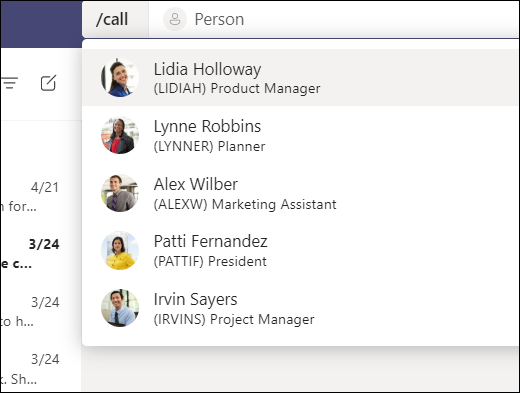First things to know about calls in Microsoft Teams
Calls are a quick way to connect in Teams. You can have one-on-one calls or calls with several people. Set them up ahead of time, like in a meeting, or start them on the fly while in a chat.
Here are the first things to know about making and managing calls in Teams:
1. There are many ways to make a call in Teams
Wherever you are in Teams, you can start a call with one or more people. Here are some of the ways:
Make or answer a call from anywhere
Select either Video call 

Answering a call is simple, too. Select Video call 

Turn a chat into a call
With one click, you can turn any chat into a call in Teams.
When you're in a chat, select Video call 

Make a call from your call history, speed dial, voicemail, or contacts
Make a call from your call history:
Go to Calls 

Make a call from your speed dial:
To access your speed dial, go to Calls 

Make a call from your voicemail:
To access your voicemail, go to History and select Voicemail in the upper-right corner. To call someone back from your voicemail, select More actions 


Make a call from your contacts:
Select Calls 

Use the dial pad
If you have a calling plan set up, you can call anyone from Teams.
To dial a number from Teams, go to Calls 

You can also type in the name of a person or group and call them from the dial pad.
Hover over someone's profile picture
Throughout the Teams app, you'll find profile pictures of people you're connected with. Sometimes people choose avatars, or you might see their initials.
Hover over a profile picture and see options to make a video or audio call to that person. Choose one of those options and your call will begin.
Use commands
Quickly find and call people or groups with commands.
At the top of Teams, type /call in the search box and then enter a name or number. The call will begin automatically when you make your selection.

Note: If you're in a Teams call on your mobile device, the device's screen won't turn off if you don't navigate away from the call window (or if you navigate away but come back before it turns off). If you turn off your screen during a call, you'll stay connected but the device will lock.
2. You can do a lot while on a call in Teams
During a Teams call, you can take many actions. Here are a few common scenarios:
Place a call on hold
Select More actions 
Transfer a call
Select More actions 
Consult then transfer
If you want to check in with someone before you transfer a call to them, select More actions 
Under Choose a person to consult, start typing the name of the person you want to reach and select them when they appear. You can call them or consult with them over chat. When you're ready, select Transfer.
Add a delegate
You can select someone in Teams to be your delegate—to receive and make calls on your behalf. When you add a delegate, you’re sharing your phone line with them, so they can see and share all your calls.
To assign a delegate, select Settings and more 
Share a line with a delegate
Select Settings and more 
3. Review your call history
Locate your call history in the center of the calls experience. There you'll see a list of past calls, including missed calls.
Go to Calls 


You can also chat with that contact, add them to speed dial, and add them to your contacts — all from the More actions 
4. Access your voicemail
Your voicemail is another tool for getting the most out of your calling experience in Teams.
Go to Calls 
-
Review messages and transcripts from calls
-
Customize call rules
-
Record a greeting
-
Call anyone who's left you a message
Call someone back from your voicemail by selecting More actions 












